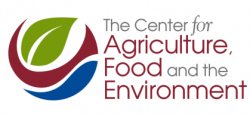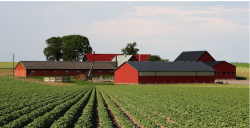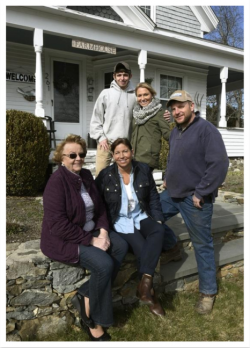Announcements
Covid-19 Updates
Webinar Series: Grazing & Forage Season Extension
Green Pasture Award Winner
10 Questions to Ask When Buying Hay for Horses
Deadline for updated Conservation Stewardship Program
NRCS Financial AssistancePrograms
COVID-19 Updates
Information on services offered by UMass Extension and the Center for Agriculture, Food and the Environment (CAFE) during these times can be found here: https://ag.umass.edu/coronavirus
For those who are looking for financial support, the USDA is providing support to agricultural commodity producers through the Coronavirus Food Assistance Program (CFAP).
Eligible to: producers (person or legal entity) of specified agricultural commodities who have suffered a five percent-or-greater price decline as a result of the COVID-19 pandemic, and who face substantial marketing costs for inventories are eligible for CFAP payments.
Application deadline: August 28, 2020
More information: https://www.farmers.gov/archived/cfap2#apply
Other USDA support for farmers and ranchers: https://www.farmers.gov/ coronavirus#:~:text=USDA's%20Coronavirus%20Food%20Assistance%20Program,face% 20additional%20significant%20market%20costs.
Mental Health Support: https://www.fb.org/programs/farm-state-of-mind
Webinar Series: Grazing and Forage Season Extension
Please register and join us!
No-Till Pasture Improvement with Rick Kersbergen of UMaine Extension
Friday, June 26, 12:15-1:00 PM REGISTER: https://attendee.gotowebinar.com/register/8516802082452911376
Brassicas and other cool-season annuals with Heather Darby of UVM Extension
Friday, July 31, 12:15-1:00 PM REGISTER: https://attendee.gotowebinar.com/register/1146633804470769936
Harvesting over-wintering cover crops with Sam Corcoran of UMass Extension
Friday, August, 28, 12:15-1:00 PM REGISTER:https://attendee.gotowebinar.com/register/5751966844713341200
Stay tuned for registration links & dates for Stockpiling with Troy Bishopp in August and The Effects of Feeding Alternative Forages on Animal Health and Performance in September (speaker to be announced).
The series is a collaboration among UMass Extension, UVM Extension, & UMainebExtension, and is supported in part by a Northeast SARE Research and Education Grant with organization and administration supported by the Livestock Institute of Southern New England via the New England Grazing Network with the support of the Cedar Tree Foundation.
For any questions about the series, please contact Sam Corcoran at sglazecorcor@umass.edu
2020 Green Pasture Award Winner
The selection committee is pleased to announce Baker Farm on 289 Locust Street Swansea, Massachusetts as the 2020 Outstanding Dairy Farmer winner.
For more information, questions, or comments, please contact: Masoud Hashemi (413) 545—1843 masoud@umass.edu
10 Questions to Ask When Buying Hay for Horses
Author: Krishona Martinson, PhD, University of Minnesota.
From: June 2020 UMN Extension Horse e-Newsletter
Summer signals a new season in hay making, buying, and selling. Horse owners who have an established relationship with a hay supplier (or suppliers) likely know details surrounding where, how, and when their hay is being produced. However, Mother Nature can throw a wrench into the best plans, and some horse owners may find themselves searching for new hay sources and providers. Here are some questions, or groups of questions, horse owners can ask when purchasing hay:
- Have you sold to horse owners before or do you specialize in hay for horses? How much hay do you have/bale each year? Compared to cattle, horses are more prone to health issues that can come from weather events, or poorly grown, harvested, or stored hay (e.g. dust, mold, toxic plants). Knowing how much hay the farmer produces helps ensure a consistent supply of hay. Some horse owners may need to develop relationships with multiple hay suppliers.
- What is the average weight of the bales? What bale types are offered? This is very important if buying hay by the bale, which is common in the horse industry. For example, a 50 pound bale that is $6 ($240 per ton) is actually a better buy than a 35 pound bale that is priced at $5 ($286 per ton). The Hay Price Calculator app can help calculate price per ton. Not all farmers produce all bale-types (e.g. small square bales, round bale, large square bales). It's best to ask this question up front as not all horse owners can handle and/or feed all bale types.
- What species are present in the hay? Legumes and grasses have different nutrient values. Legumes, like alfalfa, tend to be higher in crude protein, energy, and calcium, and lower in nonstructural carbohydrates and fiber values compared to cool-season grasses. Being able to identify common grasses and legumes also helps horse owners spot weeds.
- 4. How mature is the hay? Along with forage species, maturity is the main driver of forage quality. More mature forages will have larger stems, flowers (for legumes), and seed heads (grasses). However, more mature forages are not "bad", rather they tend to be better suited for idle horses, while less mature forages tend to be better for horses with elevated caloric requirements (e.g. performance horses and growing horses).
- Where was the hay harvested? This question helps rule out ditch hay which can contain carcasses (e.g. roadkill), garbage, and weeds.
- Was the hay rained on? Rained on hay can actually be a good choice for horses with metabolic problems as it tends to be lower in nonstructural carbohydrates. However, hay that has received excessive rainfall is not usually a good option for horses.
- Was the hay stored inside or under cover after baling? Hay stored inside or under cover has less storage loss compared to hay stored outdoors or uncovered
- Was the hay field fertilized and/or sprayed for weeds? Fields that have been fertilized show good management and likely a better quality product. Weed control is important; hay intended to feed horses should have <10% non-toxic weeds. There is a zero tolerance for poisonous plants in hay intended for horses.
- What is the price? Is there a price break for volume or cash? What are the payment options? These questions are important and often overlooked when buying and selling hay.
- Is delivery available and if so, what is the cost? Is assistance available with onsite handling and stacking of hay, and if so, at what cost? Again, important but often overlooked questions when buying and selling hay.
For more information on selecting and storing hay for horses, click here.
USDA announces next sign-up period for updated Conservation Stewardship Program
AMHERST, Mass., May 26, 2020 – The U.S. Department of Agriculture (USDA) has announced that the next deadline for Conservation Stewardship Program (CSP) applications to be considered for funding in fiscal year 2020 is June 26, 2020. USDA’s Natural Resources Conservation Service (NRCS) plans to invest up to $725 million nationwide for new enrollments and contract extensions in fiscal year 2020.
“CSP continues to be a very effective tool for private landowners working to achieve their conservation and management goals,” said Dan Wright, NRCS Massachusetts State Conservationist. “It is the largest conservation program in the United States with more than 70 million acres of productive agricultural and forest land enrolled.”
While applications are accepted throughout the year, interested producers should submit applications to their local NRCS office by June 26, 2020, to ensure their applications are considered for 2020 funding.
The 2018 Farm Bill made several changes to this critical conservation program, which helps agricultural producers take the conservation activities on their farm to the next level. Some important improvements to the program include:
- NRCS now enrolls eligible, high ranking applications based on dollars rather than acres. For fiscal 2020, NRCS can spend up to $725 million in the program, which covers part of the cost for producers implementing new conservation activities and maintaining their existing activities
- Higher payment rates are now available for certain conservation activities, including cover crops and resource conserving crop rotations.
- CSP now provides specific support for organic and transitioning to organic production activities, and a special grassland conservation initiative for certain producers who have maintained cropland base acres.
CSP is offered through continuous sign-ups. The program provides many benefits including increased crop yields, decreased inputs, wildlife habitat improvements and increased resilience to weather extremes. CSP is for working lands including cropland, pastureland, nonindustrial private forest land and agricultural land under the jurisdiction of a tribe.
For more information and to apply, contact your local USDA-NRCS office:
- Greenfield field office – 413-772-0384, ext 3, serving Franklin County
- Hadley field office – 413-585-1000, ext 3, serving Hampden and Hampshire counties
- Holden field office – 508-829-4477, ext 3, serving Worcester County
- Pittsfield field office – 413-443-1776, ext 3, serving Berkshire County
- Westford field office – 978-692-1904, ext 3, serving Essex, Middlesex and Suffolk counties
- Wareham field office – 508-295-5151, ext 2, serving Bristol, Norfolk and Plymouth counties
- West Yarmouth field office – 508-771-6476, serving Cape Cod and the Islands
NRCS is a federal agency that works hand-in-hand with conservation districts and the people of Massachusetts to improve and protect soil, water and other natural resources. MEDIA CONTACT: Diane Petit, Public Affairs Specialist, 413-253-4371, diane.petit@usda.gov
NRCS Financial Assistance Programs
- Environmental Quality Incentives Program (EQUIP):
EQIP provides financial and technical assistance to agricultural producers in order to address natural resource concerns and deliver environmental benefits such as improved water and air quality, conserved ground and surface water, reduced soil erosion and sedimentation or improved or created wildlife habitat.
More info: https://www.nrcs.usda.gov/programs-initiatives/eqip-environmental-qualit... - Conservation Stewardship Program (CSP):
The Conservation Stewardship Program helps agricultural producers maintain and improve their existing conservation systems and adopt additional conservation activities to address priority resources concerns. Participants earn CSP payments for conservation performance—the higher the performance, the higher the payment.
More info: https://www.nrcs.usda.gov/programs-initiatives/csp-conservation-stewards... - Agricultural Management Assistance Program (AMA):
AMA helps agricultural producers use conservation to manage risk and solve natural resource issues through natural resources conservation. NRCS administers the AMA conservation provisions while the Agricultural Marketing Service and the Risk Management Agency implement other provisions under AMA.
More info: https://www.nrcs.usda.gov/programs-initiatives/ama-agricultural-manageme... - For more information, contact your local USDA-NRCS office:'
- Greenfield field office – 413-772-0384, ext 3, serving Franklin County
- Hadley field office – 413-585-1000, ext 3, serving Hampden and Hampshire counties
- Holden field office – 508-829-4477, ext 3, serving Worcester County
- Pittsfield field office – 413-443-1776, ext 3, serving Berkshire County
- Westford field office – 978-692-1904, ext 3, serving Essex, Middlesex and Suffolk counties
- Wareham field office – 508-295-5151, ext 2, serving Bristol, Norfolk and Plymouth counties
- West Yarmouth field office – 508-771-6476, serving Cape Cod and the Islands


